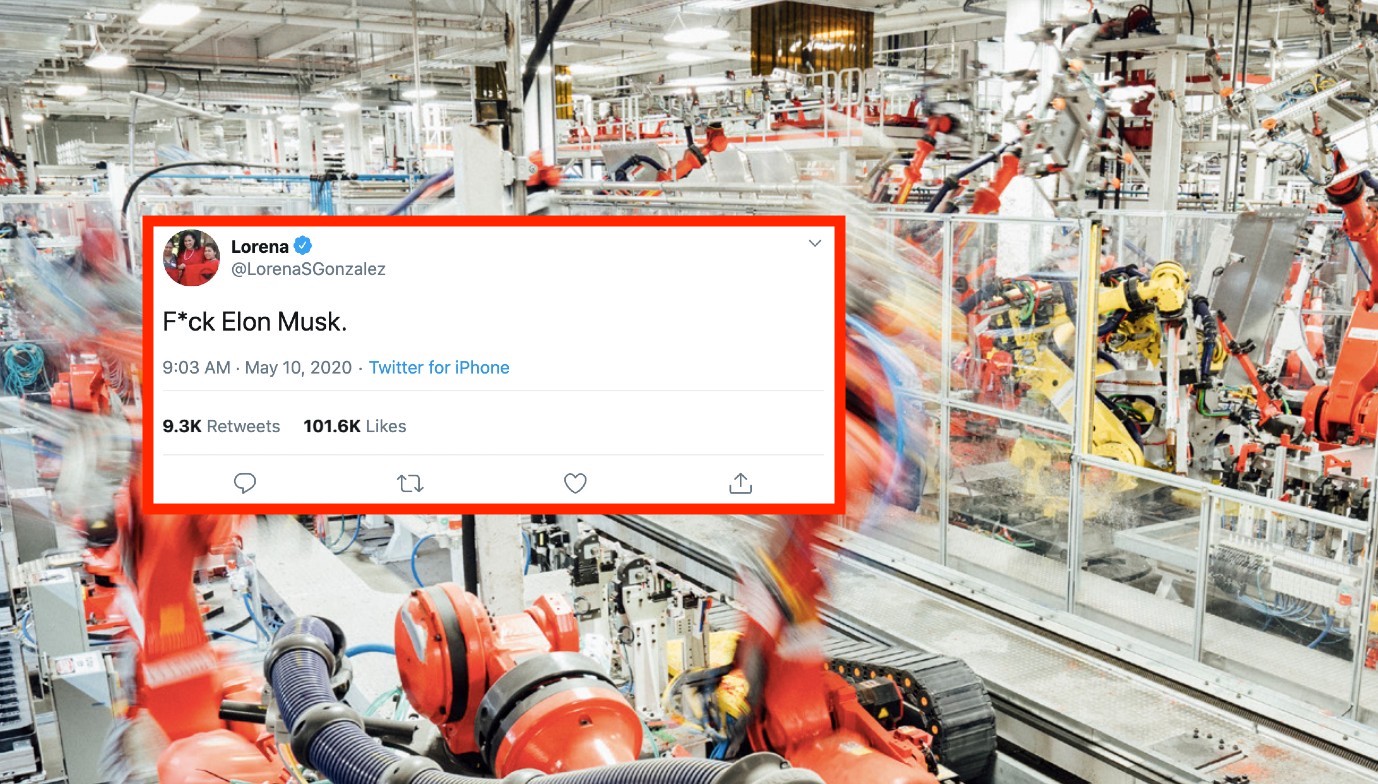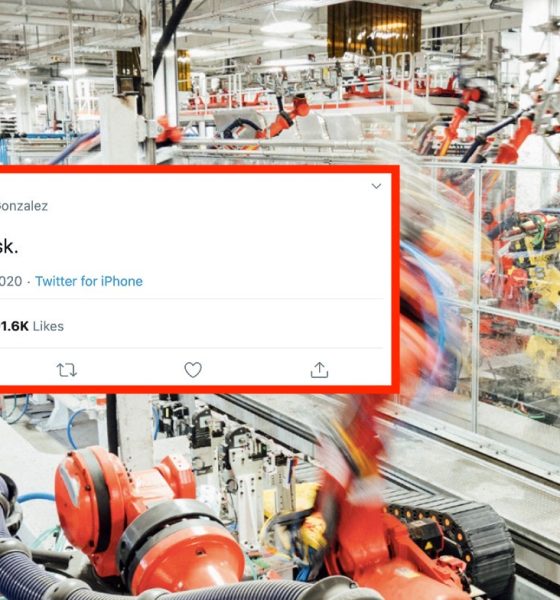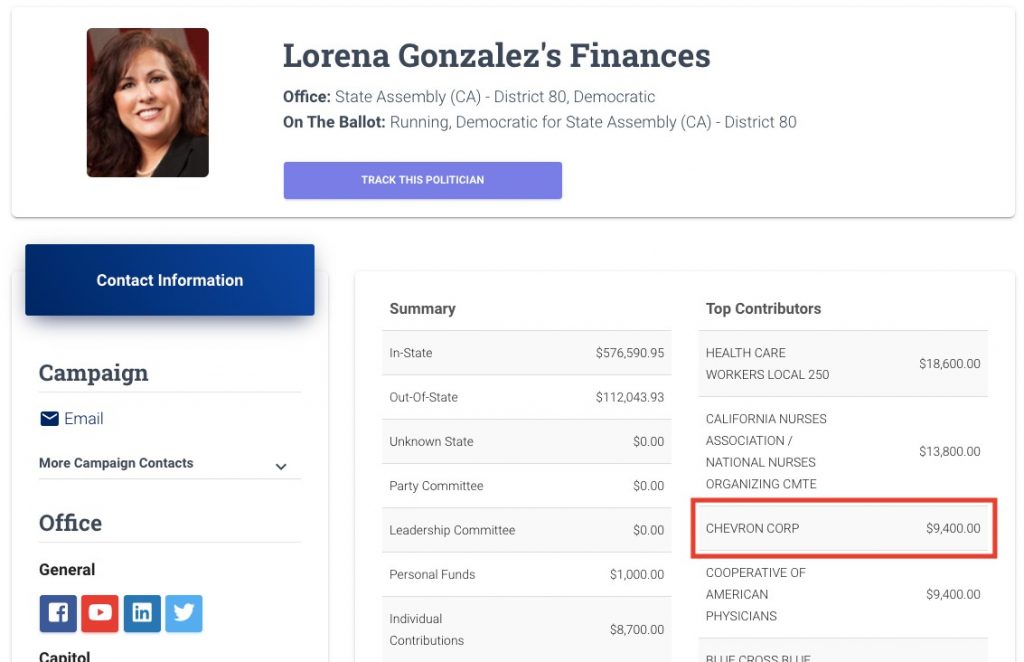

News
Tesla’s Elon Musk gets cursed-out by CA politician who’s backed by Chevron
Among the adverse reactions to Tesla and Elon Musk’s stance on the ongoing shutdown of the Fremont factory, the most drastic would have to come from CA Assemblywoman Lorena S. Gonzales. The politician opted to give her two cents on the unfolding series of events this past weekend, and they were interesting, to say the least.
Instead of providing a formal statement of support for Tesla like Fremont Mayor Lily Mei, or an argument about why the factory should not reopen yet like former Secretary of Labor Robert Reich, Gonzales decided to keep her points as succinct as possible. In a tweet, the CA assemblywoman simply posted a message declaring “F*ck Elon Musk.”
Gonzales would later add a couple more points in her initial “F*ck Elon Musk” message. In a series of follow up tweets, Gonzales accused Tesla of being a highly-subsidized company that has “always disregarded worker safety and well-being.” She also claimed that the company has “engaged in union busting” and that it “bullies public servants.”
The CA assemblywoman’s follow-up tweets contain usual talking points against the electric car maker. Accusations about worker safety, for example, mirror those of an alleged expose by Reveal magazine back in 2018, which Tesla has already responded to. Musk has also noted that Fremont employees are free to unionize, though organizations such as the UAW are not particularly popular among the plant’s workers considering the union’s failures during the facility’s days as the NUMMI plant.
Interestingly enough, a look at Gonzales’ page on politician-tracking platform VoteSmart shows that the CA assemblywoman lists Chevron, one of the world’s premier fossil fuel companies, as her third-biggest contributor for the 2020 cycle. A look at Gonzales’ fundings from top industries also reveals that she has received funds from the “Oil and Gas” segment.

There are many ways to express grievances against Musk and Tesla, though it is difficult to deny that Gonzales’ simple profanity-laden statement is a bit unusual for a government official. Off-the-cuff comments may be the trend nowadays with politics spilling over to online platforms, but it is still a bit off to see overtly aggressive posts such as “F*ck Elon Musk” coming from a CA assemblywoman. Such statements are common to the TSLAQ community and outspoken short-sellers, but one would expect an elected official to behave online differently.
Amidst the ongoing shutdown of the Fremont factory, Scott Haggerty, the county supervisor for the district in Alameda County, suggested to the New York Times that things would have been better had Musk not filed a lawsuit against the county. According to Haggerty, Tesla was poised to reopen the Fremont factory on May 18, but Musk wanted the factory to resume operations earlier. With Tesla filing a lawsuit against the county, Haggerty warned that things would likely be delayed further.

“We were working on a lot of policies and procedures to help operate that plant, and quite frankly, I think Tesla did a pretty good job, and that’s why I had it to the point where on May 18, Tesla would have opened. I know Elon knew that. But he wanted it this week.”
“It (the lawsuit) was only a threat, and as an elected official, I get threatened all the time. It does, at that point, slow down conversations between my contact at the plant and myself. He could have spent time enjoying his new baby and given me and my staff a couple more days, and his plant would have been open on May 18. Am I somewhat sympathetic with Tesla? Yes, I am. Am I sympathetic to the way Musk is treating people? No.” Haggerty said.
Other automakers in the United States are not on the same boat as Tesla. General Motors, Ford, and Fiat-Chrysler have stated that they will resume operations on May 18. Toyota intends to reopen its US plants on May 11. German automaker Mercedes-Benz has already resumed operations at its SUV plant in Alabama, as well as a van factory in South Carolina.

News
Tesla starts showing how FSD will change lives in Europe
Local officials tested the system on narrow country roads and were impressed by FSD’s smooth, human-like driving, with some calling the service a game-changer for everyday life in areas that are far from urban centers.

Tesla has launched Europe’s first public shuttle service using Full Self-Driving (Supervised) in the rural Eifelkreis Bitburg-Prüm region of Germany, demonstrating how the technology can restore independence and mobility for people who struggle with limited transport options.
Local officials tested the system on narrow country roads and were impressed by FSD’s smooth, human-like driving, with some calling the service a game-changer for everyday life in areas that are far from urban centers.
Officials see real impact on rural residents
Arzfeld Mayor Johannes Kuhl and District Administrator Andreas Kruppert personally tested the Tesla shuttle service. This allowed them to see just how well FSD navigated winding lanes and rural roads confidently. Kruppert said, “Autonomous driving sounds like science fiction to many, but we simply see here that it works totally well in rural regions too.” Kuhl, for his part, also noted that FSD “feels like a very experienced driver.”
The pilot complements the area’s “Citizen Bus” program, which provides on-demand rides for elderly residents who can no longer drive themselves. Tesla Europe shared a video of a demonstration of the service, highlighting how FSD gives people their freedom back, even in places where public transport is not as prevalent.
What the Ministry for Economic Affairs and Transport says
Rhineland-Palatinate’s Minister Daniela Schmitt supported the project, praising the collaboration that made this “first of its kind in Europe” possible. As per the ministry, the rural rollout for the service shows FSD’s potential beyond major cities, and it delivers tangible benefits like grocery runs, doctor visits, and social connections for isolated residents.
“Reliable and flexible mobility is especially vital in rural areas. With the launch of a shuttle service using self-driving vehicles (FSD supervised) by Tesla in the Eifelkreis Bitburg-Prüm, an innovative pilot project is now getting underway that complements local community bus services. It is the first project of its kind in Europe.
“The result is a real gain for rural mobility: greater accessibility, more flexibility and tangible benefits for everyday life. A strong signal for innovation, cooperation and future-oriented mobility beyond urban centers,” the ministry wrote in a LinkedIn post.
News
Tesla China quietly posts Robotaxi-related job listing
Tesla China is currently seeking a Low Voltage Electrical Engineer to work on circuit board design for the company’s autonomous vehicles.

Tesla has posted a new job listing in Shanghai explicitly tied to its Robotaxi program, fueling speculation that the company is preparing to launch its dedicated autonomous ride-hailing service in China.
As noted in the listing, Tesla China is currently seeking a Low Voltage Electrical Engineer to work on circuit board design for the company’s autonomous vehicles.
Robotaxi-specific role
The listing, which was shared on social media platform X by industry watcher @tslaming, suggested that Tesla China is looking to fill the role urgently. The job listing itself specifically mentions that the person hired for the role will be working on the Low Voltage Hardware team, which would design the circuit boards that would serve as the nervous system of the Robotaxi.
Key tasks for the role, as indicated in the job listing, include collaboration with PCB layout, firmware, mechanical, program management, and validation teams, among other responsibilities. The role is based in Shanghai.
China Robotaxi launch
China represents a massive potential market for robotaxis, with its dense urban centers and supportive policies in select cities. Tesla has limited permission to roll out FSD in the country, though despite this, its vehicles have been hailed as among the best in the market when it comes to autonomous features. So far, at least, it appears that China supports Tesla’s FSD and Robotaxi rollout.
This was hinted at in November, when Tesla brought the Cybercab to the 8th China International Import Expo (CIIE) in Shanghai, marking the first time that the autonomous two-seater was brought to the Asia-Pacific region. The vehicle, despite not having a release date in China, received a significant amount of interest among the event’s attendees.
Elon Musk
Elon Musk and Tesla AI Director share insights after empty driver seat Robotaxi rides
The executives’ unoccupied tests hint at the rapid progress of Tesla’s unsupervised Robotaxi efforts.

Tesla CEO Elon Musk and AI Director Ashok Elluswamy celebrated Christmas Eve by sharing personal experiences with Robotaxi vehicles that had no safety monitor or occupant in the driver’s seat. Musk described the system’s “perfect driving” around Austin, while Elluswamy posted video from the back seat, calling it “an amazing experience.”
The executives’ unoccupied tests hint at the rapid progress of Tesla’s unsupervised Robotaxi efforts.
Elon and Ashok’s firsthand Robotaxi insights
Prior to Musk and the Tesla AI Director’s posts, sightings of unmanned Teslas navigating public roads were widely shared on social media. One such vehicle was spotted in Austin, Texas, which Elon Musk acknowleged by stating that “Testing is underway with no occupants in the car.”
Based on his Christmas Eve post, Musk seemed to have tested an unmanned Tesla himself. “A Tesla with no safety monitor in the car and me sitting in the passenger seat took me all around Austin on Sunday with perfect driving,” Musk wrote in his post.
Elluswamy responded with a 2-minute video showing himself in the rear of an unmanned Tesla. The video featured the vehicle’s empty front seats, as well as its smooth handling through real-world traffic. He captioned his video with the words, “It’s an amazing experience!”
Towards Unsupervised operations
During an xAI Hackathon earlier this month, Elon Musk mentioned that Tesla owed be removing Safety Monitors from its Robotaxis in Austin in just three weeks. “Unsupervised is pretty much solved at this point. So there will be Tesla Robotaxis operating in Austin with no one in them. Not even anyone in the passenger seat in about three weeks,” he said. Musk echoed similar estimates at the 2025 Annual Shareholder Meeting and the Q3 2025 earnings call.
Considering the insights that were posted Musk and Elluswamy, it does appear that Tesla is working hard towards operating its Robotaxis with no safety monitors. This is quite impressive considering that the service was launched just earlier this year.








